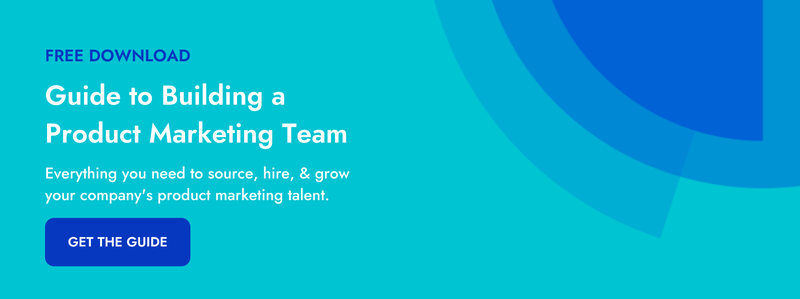Whenever I start a new product marketing role, I’m always racing to accelerate my learning curve. There’s no escaping that the effective messaging, personas, and fundamentals of this craft demand prerequisite knowledge first. I find myself thinking, “Until I understand the wider context, I can’t even think about starting a meaningful persona and messaging matrix...” Getting through this inevitable “new person” period of figuring out a role that every company defines differently, and sponging up the necessary knowledge at every step, feels like forever.
What I’ve realized is this: there is a way to accelerate the clock. Prioritize competitive intelligence (CI) as the #1 onboarding project out of the gate.
If there’s a single opportunity to arm yourself or a new member of your team with stronger knowledge of the company, its place in the market, and audit the marketing in your space in one fell swoop, competitive intelligence is it. It’s a “kill three birds with one stone” way to accomplish multiple forms of learning and discovery critical to a product marketer’s skillset. Doing this sooner rather than later will help your product marketer move towards making an early impact on your business.
Here are the top reasons why CI should be the go-to onboarding project for new product marketing hires.
Why Start with Competitive Intelligence
Product marketers have to ramp up fast to gain a near-PhD worth of knowledge about the market, industry, and products. So for both managers and new employees alike, it’s often a question of “Where to start?” And CI is a best-bang-for-everyone’s-buck place to begin.
Conducting a CI investigation takes you on a tour through the marketplace spanning multiple levels. You can break these down into three main “L’s”:
- Lowdown on Competitor Who’s Who
- Landscape of the Market & Industry
- Language of Marketing & Messaging in your space
CI research allows you to explore each “L”, gaining knowledge that ultimately informs the wider body of product marketing work to come next on the job.
The journey often looks like this:
- Start with the basic competitor “Lowdown” to absorb the fundamentals. Use what you have access to--even a thorough website and social media audit exposes you to information about their products and recent news to drill into. Who are the key players, new entrants? What do they offer, what’s new or changed? What are they emphasizing compared to us?
- Next, pull in the wider “Landscape” market context by comparing the above against analyst reports and industry publications (even just the free summaries if you don’t have a subscription!). Now you’re assessing: What do the experts call attention to in this market? What topics keep surfacing and which trends are perceived as urgent? What are the gaps vs what I’m reading elsewhere?
- Best of all, by paying attention to the “Language” you’re seeing along the way, you’ll naturally end up inspecting the messaging to build a mental inventory of the marketing in this space. How are rivals talking about their products? What concepts and words are repetitive and clearly table stakes where we wouldn't stand out? What can I take away to inform how we should be messaging differently? Appraise competitor content and collateral to take stock of the commonalities and the gaps you might target instead.
The trick here is that by ingesting all three L’s in the same course of research, you’ve gained an all-in-one foundational layer of knowledge absorbed simultaneously. The product marketing to-do list not only has checkmarks next to competitive intelligence and market research, but also prime ingredients of messaging, positioning, personas, and a wider marketing strategy, all informed by this single effort. The before and after comparison of how you would approach “jobs to be done” is starkly different, thanks to context and data-backed insights at your command.
Note to seasoned pros: even if you’re familiar with the market and competitive mix already, going through this process again at the start of any new job is worth it to ensure you’re armed with the freshest insights.
Additional Benefits of Competitive Intelligence First Onboarding
The benefits don’t stop with knowledge alone. The competitive intelligence research also triggers additional benefits that further increase your product marketing effectiveness in subtle--but significant--ways.
Boost Your Confidence
Once on the other side of the CI effort, you’re seeing the market with greater clarity and standing on far more familiar ground. This clears the way for a natural lift in confidence.
While you still may not be a complete expert, you’re making points and developing plans with greater reassurance that they’re backed by solid context. With this comes a sureness and degree of trust in ourselves, which we can leverage to feel better about what we’re doing and project this assuredness outward. It’s a valuable aspect of finding our groove sooner, lifted by the feeling that the path forward is bright, and we’re ready to take on everything the role will throw at us next.
Validate Assumptions
A freshly-minted round of CI discovery also positions you to scrutinize long-held assumptions that may be worth dusting off for closer inspection.
You’re still fresh enough to bring an outside perspective, but now you’re dialed into the market dynamics to assess with informed eyes. This can be a valuable stance to help the organization question and probe into incumbent ideas, stale messaging, or market perceptions that may benefit from rethinking. Posing informed questions that cause others to think in new ways is a great way to foster conversations, build relationships, and deepen your engagement with other teams--all key to cementing your place in the organization.
Make Your Mark
Lastly, this is a great chance to show what you bring to the table that’s uniquely “you.”
You’re the one at the helm of this research and shaping what the deliverable looks like--a perfect platform to put your stamp on and bring something compelling into the mix. Don’t be afraid to put forth something distinct or impactful, whether dynamite presentation skills, slick slide-building smarts, asking a question that no one else thought to pose, pulling up a piece of market intel that got overlooked and can inform wider strategy and planning, or something else entirely. Treat this as your platform to stand up and bring what you uniquely bring, reminding everyone why they hired you in the first place, and building excitement to work with you going forward.
Mandatory Milestone
With so much standing to gain from a competitive intelligence project early-on, it merits consideration as a mandatory milestone for any new product marketer on the job.
Whether you’re the self-motivated newbie, or planning the ramp-up plan for your newest direct report, commit to embedding CI in that new hire process. Keep it from falling through the cracks, or a “nice to have” displaced by other projects by assigning a purposeful deliverable. The effort will pay off far beyond the initial slide deck or presentation where it takes form--shortening that product marketer’s path from high-potential to high-performer and taking the company even further.

Related Blog Posts
Popular Posts
-
 How to Create a Competitive Matrix (Step-by-Step Guide With Examples + Free Templates)
How to Create a Competitive Matrix (Step-by-Step Guide With Examples + Free Templates)
-
 The 8 Free Market Research Tools and Resources You Need to Know
The 8 Free Market Research Tools and Resources You Need to Know
-
 Sales Battlecards 101: How to Help Your Sellers Leave the Competition In the Dust
Sales Battlecards 101: How to Help Your Sellers Leave the Competition In the Dust
-
 6 Competitive Advantage Examples From the Real World
6 Competitive Advantage Examples From the Real World
-
 How to Measure Product Launch Success: 12 KPIs You Should Be Tracking
How to Measure Product Launch Success: 12 KPIs You Should Be Tracking





